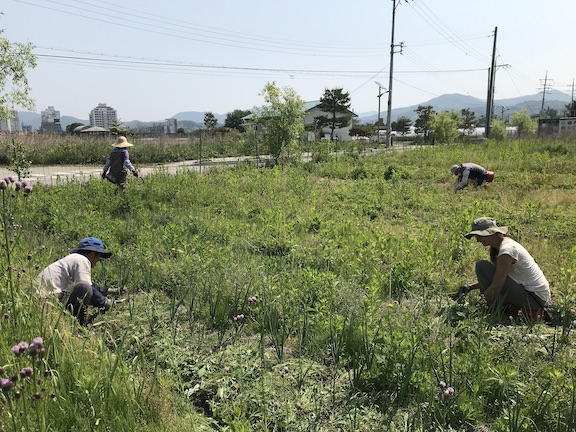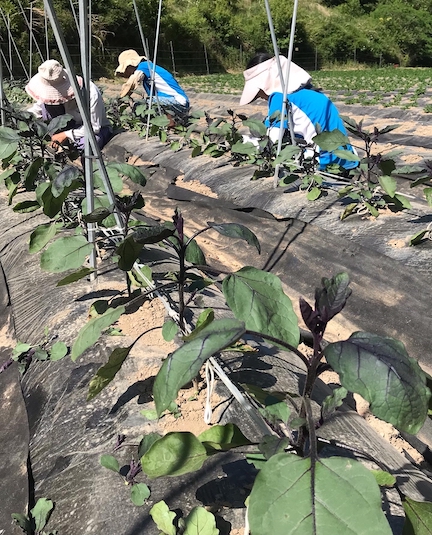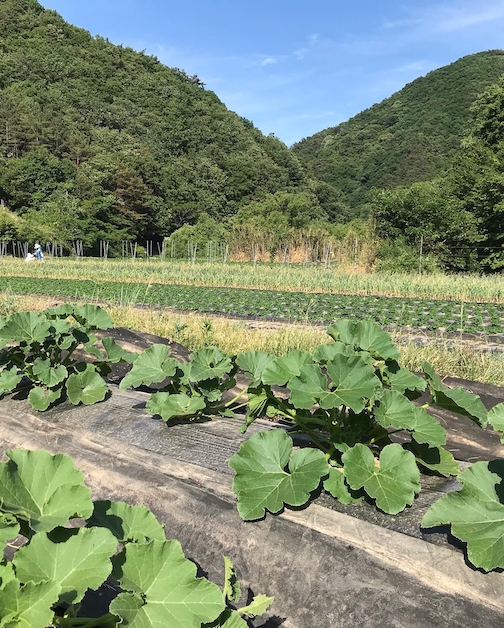By Eesha Williams and Elizabeth Wood
Photos courtesy of the authors
After 20 years of organic vegetable farming, in 2022, we planted our farm, New Leaf CSA, near Brattleboro, Vermont, with cover crops and set out to see how farmers in other countries approach the challenges of farming. South Korea offered some great opportunities for us to visit small-scale organic farms and learn from farmers.

The Korean countryside is full of green, forested mountains and small farms. The climate is cold in the winter and hot in the summer, with a very humid, rainy season from late June into July. In many ways, rural South Korea looks a lot like Vermont. However, while Vermont has many acres of cow pasture and feed corn, most of the farmland in Korea is devoted to rice.
We found the opportunity to experience life on small Korean farms through Worldwide Opportunities on Organic Farms (WWOOF) and Workaway. Through these organizations, volunteers work (usually about five hours per day) in exchange for a place to sleep and three meals a day. Visits can be as short as one day or last several months, and no previous farming or gardening experience is required.
Farm Stays in South Korea
Our first WWOOF hosts, Shinbeom and Jeongwa of Amuse By Farm near Seoul, practice a method of no-till farming inspired by Japanese farmer and philosopher Masanobu Fukuoka. At Amuse By Farm, the farmers do not use plastic mulch or weed mat, but the soil is never left bare. Weeds are cut just above the soil surface and chopped to form a mulch that covers each of their permanent raised beds. This cutting and chopping is all done by hand and is very labor intensive. It was inspiring to see that this couple in their 30s is able to derive some income from (and produce a lot of high-quality food, including a large portion of their household food needs) under an acre of land with such stringently eco-friendly methods.
Amuse By is surrounded by non-organic farms that we guessed to be about 1 to 10 acres each, which mostly grow rice but also produce some cattle and vegetables. They use plastic mulch, tractors and greenhouses. Most of these farms are run by older farmers who seem mystified by Amuse By’s farming methods. Shinbeom and Jeongwa’s neighbors tell them they are doing things the hard way and offer to share herbicides, but Shinbeom and Jeongwa seem to really enjoy their way of farming. One thing we admired about Amuse By Farm is the philosophy that is summed up in the farm’s name: the farm should bring joy to the farmers. The farmers’ city friends say they have nothing in their urban work lives that amuses them or brings a smile to their faces. This ideal, for many of us, can easily get lost in the busyness of life.
The next farm we volunteered at, 100 Flowers Farm near Gyeongju, is an organic vegetable farm that produces 135 weekly Community Supported Agriculture (CSA) shares. (100 Flowers Farm does not grow flowers — it was named after a mountain.) Our hosts, Jo and Jeonseon, practice traditional Korean farming methods such as making fermented fertilizers and pruning vegetables in accordance with ancient Korean farming texts. They till the soil and create raised beds using a rugged walk-behind tractor, which is the standard method of tillage on most Korean farms.

Our experiences on these farms gave us a glimpse of the cultural life of rural Korea. None of the farmers who we worked with had grown up on farms. All had left white-collar jobs in the cities to start farms. Jeongwa at Amuse By said she and her husband Shinbeom loved WWOOFing in the United Kingdom and Europe so much that they decided to become farmers and WWOOF hosts. Jeonseon at 100 Flowers Farm said one of her main sources of inspiration for leaving city life was reading Henry David Thoreau’s “Walden.”
Korean Farming Techniques
We talked with our hosts about the ways in which small-scale vegetable farming in Korea is different than in the United States. Here are a few things that we found interesting:
At 100 Flowers Farm we pruned a lot of vegetable crops that don’t usually get pruned at our farm such as winter squash, peppers and eggplant. This encourages the plants to set large, high-quality fruit rather than lots of small fruits. Peppers and eggplant are both pruned and trellised to increase airflow and reduce incidence of disease.

In South Korea most farms only own a small, walk-behind tractor. Many farm communities have larger tractors that farmers can rent for heavier tillage projects.
Both farms mail vegetables overnight directly to their customers either through the Korean postal service or a private courier. The shipping cost is very affordable (about $3 U.S. per box to anywhere in South Korea).
In South Korea farms do not typically wash produce. There is a belief that washing removes natural bacteria and substances that keep food fresh. The bacteria are also important for making fermented foods such as kimchi. (It is interesting to note that, on average, South Koreans live longer than Americans.)
Farms in South Korea (and in most parts of Asia) use ropes or straps that go over the entire greenhouse to help secure the plastic cover against strong wind. At one of the farms we worked at, the ropes attached to a cable at ground level that is attached to the frame. We also saw straps individually staked into the ground.
In South Korea, traditionally organic farmers spray a mixture of diluted sea water and vinegar in which egg shells have been soaking on ripening vegetables, such as tomatoes, to make crops taste sweeter.
The South Korea farmers’ union had a major win a few years ago when a law it had lobbied for was enacted. The law says all vegetables in school lunches must be local and organic. (In comparison, we think U.S. school lunches often look like they came from a fast food chain.)
In response to our social media posts about Korean farming techniques, we are often asked, “Does it work?” That’s a difficult question for us to answer because, even though some of these practices may be ancient, we heard about them for the first time very recently. It is clear to us that some farmers in Korea believe that these practices work, otherwise they would not continue using them, but we cannot speak to how well they work relative to other methods and whether they are equally applicable in U.S. growing conditions.
The real value of the knowledge that comes from traveling is the questions it opens up, rather than the answers. Seeing that things can be done in very different ways brings forth new ideas and possibilities. This can give us confidence to try new things.
If you find this article interesting, we encourage you not only to try things at home but to get out and travel. If you visit farms in South Korea or anywhere else in the world you will probably find your own long list of new things of to try. You will return with different ways of thinking about your farm and the world.
Elizabeth Wood started the New Leaf CSA in Dummerston, Vermont, in 2002. She still runs it. Eesha Williams helps on the farm. He wrote the book “Grassroots Journalism.”
This article originally appeared in the spring 2023 issue of The Maine Organic Farmer & Gardener.
